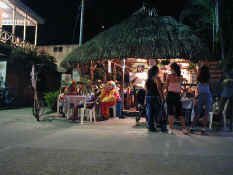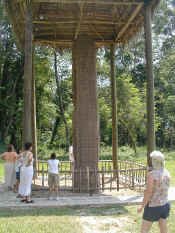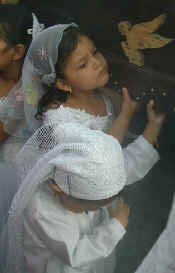March 19, 2005
After leaving Finca Ixabel in the late morning, we drove to the town of Rio Dulce. Rio Dulce is on the river of the same name, which is an outlet of Lago de Izabel. The river leads to the Caribbean Sea, so the area is very popular with "yachties" looking for a spot off the ocean.
The road into town was very narrow and crowded with busses, cars and trucks. We just added to the mix and patiently made our way toward the bridge that crosses over the river. Just before the bridge, we were able to turn off into a large parking area. We immediately were approached by a man who wanted to put us on a boat to the town of Livingston.
Livingston is a town reachable only by boat and it is populated by black Guatemalans who speak Spanish, Garifuna and English. They are descendents of Africans brought to the New World as slaves. They've developed their own culture and language.
The man who approached us helped us find a spot to park the vehicle overnight (Bruno's Hotel, Restaurant and Marina) and put us on a boat to Livingston. The boat ride took about an hour and was a beautiful trip down the river, across a gulf and through a gorge. We saw lots of cormorants and egrets.
When we arrived in Livingston, we immediately looked for a room and found a cute place in a quiet location, complete with mosquito nets. We soon set out to explore. It was Saturday afternoon, so the town was getting ready to kick into gear for the evening. We sat down and ordered some ceviche (raw fish marinated in lime and spices) and watched the action. Across from our seats was a restaurant that seemed to attract a wide mix of people. The first ones to attract our attention were a group of scantily clad women. They took up residence at tables in front of the restaurant and proceeded to hold court. Eventually they started braiding hair and had quite a clientele going by the time we left.
| Next to show up was a clown riding an oversize bicycle and wearing a rainbow wig and red nose. He had an extra nose and wig and shared them with another fellow who was trying to attract customers for his guiding service. Amid all this were the various and sundry people living and visiting the town. We had a blast watching the world go by. |
March 20, 2005
In the morning we had a leisurely breakfast overlooking the river and caught a boat back toward Rio Dulce. On the return trip the boat driver stopped to show us some hot springs flowing right into the river. There was a group of guys sitting in a pool, made by holding the hot water in with a circle of rocks, that didn't seem to mind our boat stopped just inches away.
Unable to locate the road we wanted to take to find a camping area, we decided to head south to the ruins of Quirigua. Thinking we would park for the night in a hotel parking lot, we checked a couple out. The hotel in Quirigua had difficult access and the hotel in the town down the road wanted $20.00US for us to park in their parking lot for the night. This was the same price as a single room. We declined and headed back up the road to a town on the shore of Lago Izabel, Mariscos. We were a little worried as it was now getting dark and one of our rules is no driving after dark. As luck would have it, we found a campground that wasn't listed in our guidebook, Playa Escondida. As this week is Semana Santa, people all over Central America are on vacation. There was a large group playing loud "Guatemalan Pop" in the campground, but we were glad to have found a spot. The music finally went off at midnight.
March 21, 2005
| In the morning we headed back to the ruins at Quirigua. This archaeological site is famed for its intricately carved stelae. These are gigantic sandstone monoliths up to 10.5m tall. Quirigua's location lent itself to the carving of the giant stelae as the nearby Rio Motagua had large beds of brown sandstone. Soft when wet, the sandstone dried hard. Cauac Sky (AD725-84) ruled during the time of carving and the stelae are dedicated to his glory, he had his face caved on most of them. |
Leaving Quirigua, we continued down the road to Chiquimula. This town lies in prime tobacco-growing country and though small, is a major market town for Eastern Guatemala. Also as this is Semana Santa, there was bound to be a procession going on somewhere in town - and low and behold, the children's procession was scheduled for this evening.
| At 5:00pm, the doors of the church opened and the male children began carrying out a statue of Christ on a large float held on their shoulders. The female children followed behind carrying a float with a statue of the Virgin Mary. Helped by adults along the way, the kids carried the floats for several blocks around the town square. As Don bobbed and weaved his way among the marchers to capture the moment in our camera, the parents smiled and seemed proud that a stranger was interested in their children and their culture. |
March 22, 2005
Less than an hour out of Chiquimula, we came to the Guatemalan border with Honduras. This was supposed to be a road that was not only dirt but winding as it crossed the mountains. It seems that sometime after our maps were made, the road was straightened and - surprise- paved. At the border we once again grabbed our passports and the paperwork for the vehicle and headed to deal with officialdom. Once again, the immigration and customs people were polite and efficient and we were done with both sides of the border within 45 minutes. This is now three border crossings that have been as easy as could be and quite contrary to what we had been led to believe. That's not to say that others haven't had long waits (4 hours), but we have gotten extremely lucky so far.
We continued on to the town of Ruinas Copan. We had lunch in a restaurant and enjoyed walking around the streets of this cobblestoned town. We actually drove the expedition vehicle into the center of town and with only a couple of exceptions, we were able to easily negotiate the streets.
Outside of town, we negotiated a place to park for the night at a Balneario (swimming park). We were allowed to use the facilities and the swimming pool was very nice on this very hot afternoon. It also allowed us to experience the local middle class during their leisure time. It was a very enjoyable afternoon. In the morning we'll had back to town so that we can explore our last Mayan ruin of this expedition, the ruins and stelae at Copan.


